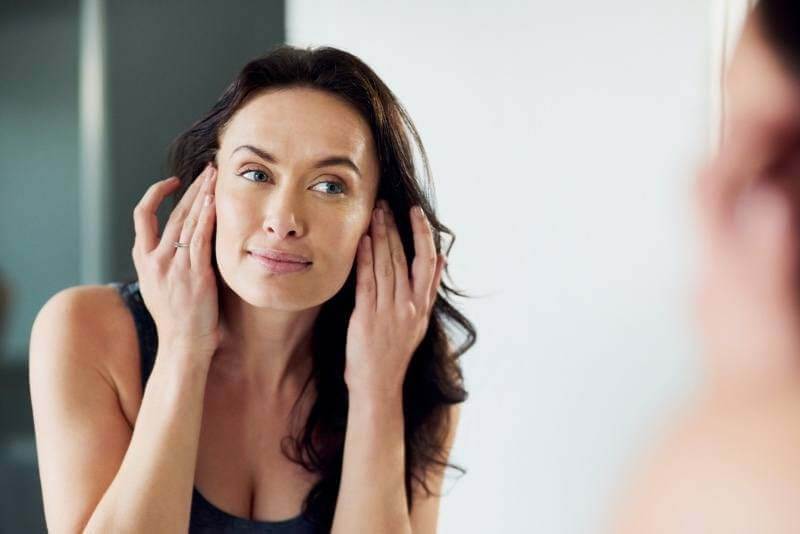As we age, our skin inevitably changes. From varicose veins to crow’s feet, we develop curiosities that make us question how to regain that youthful appearance we once knew. So, how do you treat those issues, and which purported methods of combatting the aging process are effective? With help from some local experts, we’re debunking common myths about aging skin and finding out what we can do to ease our woes.
7 Common Myths of Aging Skin
MYTH: We can turn back the clock on the aging process.
TRUTH: We can’t stop time, that’s a given. But can we hit rewind on the aging process to make the transition a little smoother? According to plastic surgeon Don Griffin, M.D., of Nashville Cosmetic Surgery, if it sounds too good to be true, it likely is. “The key is to reverse the damage done over time and then slow the future aging process,” he says.
But while there are treatments to help reverse and slow the effects of aging, no one treatment can permanently thwart the process. “Just as with most things in life, it’s the consistent combination of daily habits that add up over time that are your best anti-aging weapons,” Dr. Griffin continues. He also offers a few healthy habits to adopt, including the use of a good sunscreen every day, not smoking, and using a good retinoid as well as alternating with vitamin C to keep your collagen production up.
“If you really want results and your budget permits,” he adds, “schedule regular skincare treatments like Halo laser and Forever Young BBL [light therapy] to help you erase and slow the effects of aging.”

MYTH: Stress is the leading cause of wrinkles.
TRUTH: Stress is often credited as being the foremost cause of wrinkles. Facial Rejuvenation Center’s owner and co-director, Laurie Hays, BA, RN, disagrees. “Sun damage is the number one cause of wrinkles,” she says. “Age spots and other forms of discoloration can be seriously exacerbated by the sun’s harmful UV rays. Cortisol, the primary stress hormone, has been known to break down the collagen in your skin, among other things.”
While stress may not be the leading cause of wrinkles, Dr. Griffin says it still plays a role. “When your body is under stress, cortisol is released. Studies have shown that it can be a major contributing factor to the breakdown of collagen and elastin in your skin,” he explains. “New studies are confirming that constant stress shortens our telomeres, which are associated with cellular aging, and that by decreasing the level of stress, you can reverse some of the damage. So, we should all be concerned about reducing the amount of stress in our lives.”
Dermatologist Anna Land, M.D., of Ren Dermatology, backs that up, adding, “Incorporating stress-relieving activities such as regular exercise, yoga or meditation can be another tool in your anti-aging arsenal.”
RELATED: The Top Health & Wellness Trends for 2020
MYTH: Smiling “too much” causes fine lines.
TRUTH: Laurie says this has some truth to it. “Smiling can lead to fine lines and wrinkles at a younger age,” she tells us. “Each time a person uses a facial muscle, a groove forms under the surface of the skin.”
But what’s the alternative? “I’d rather be happy and smiling with a few extra crows feet around my eyes, than walking around with a blank, expressionless face all day,” says Dr. Griffin. “And compared to the damage from sun exposure and smoking, the effect of smiling is much less.”
Dr. Land agrees, saying, “It is impossible to live life expressionless, and can you imagine how boring that would be? Smiling also makes people seem more approachable and attractive — not to mention, it decreases stress, boosts your mood and allows human connection.” We couldn’t agree more.

MYTH: Anti-aging creams reverse fine lines.
TRUTH: Many of us turn to anti-aging creams to combat pesky lines and wrinkles. But do they do the trick on reversing the damage? “Reverse is a strong word,” says Laurie. “If the product contains retinol, you can expect to see smoother, brighter, firmer skin. Retinol is an active form of vitamin A. As we age, our bodies lose vitamin A naturally, which is what helps create those signs of aging, such as wrinkles and a dull complexion. Retinol essentially teaches aging skin cells how to behave like younger, healthier cells by encouraging them to turn over more rapidly.”
She also mentions another key ingredient in anti-aging skincare is antioxidants, which promote repair and healing. “Their main anti-aging benefit is prevention, helping to protect the skin from free radical damage and environmental stressors such as UV damage or pollution.”
MYTH: Sticking with the same consistent skincare routine throughout the year will keep my skin from aging more quickly.
TRUTH: Dr. Land says using the same products year-round, despite the change in season or skin condition, is one mistake she often sees patients make. “Having dry, tight and/or itchy skin is a common complaint, especially in the cooler months when the air is less humid, and central heating can strip additional moisture from the skin,” she says. “And age-related loss of oil and sweat glands can exacerbate this condition over time and accelerate signs of aging. It can also be caused by people trying several different exfoliating topical treatments or procedures at once and overwhelming the skin. Instead, I encourage people to add gentle and moisturizing treatments into their regimen when this condition arises. In particular, hyaluronic acid, a natural sugar molecule that occurs in the body and attracts water, functions as a great moisturizer. It keeps the skin glowing and fresh as opposed to tight and dry.”
RELATED: Insider Secrets From a Local Hair Stylist
MYTH: Collagen is the fountain of youth — true or false?
TRUTH: Collagen is in vogue these days, with benefits that purportedly include stronger bones and a youthful complexion, but Dr. Griffin says it’s probably too soon to know if it’s truly the “fountain of youth.” He can, however, confirm that collagen provides the volume in our skin, which is what keeps it looking plump. He also says it is rich in amino acids, which are necessary for the repair of our bones and joints, and that the reason our skin thins and wrinkles as we get older is through the loss of collagen and elastin.
Dr. Land adds, “Although more research is needed to draw definitive conclusions, there are several compelling studies that suggest ingesting collagen peptides for at least six weeks will increase natural collagen and hyaluronic acid production, as well as improve the elasticity of the skin. Given that there is only a small amount of data on the efficacy of these products, I encourage people to talk with their internist before any supplement regimen — especially if they have any underlying medical conditions.” She goes on to say that supplements can work to help improve the skin, but for best results, they should be combined with a healthy diet, lifestyle and skincare regimen.
MYTH: Crossing your legs causes varicose veins.
TRUTH: “Although crossing your legs may make [varicose veins] temporarily appear more obvious,” says Dr. Land, “this is not the underlying cause. Genetics play a large role in this case. Other causes, including obesity, pregnancy, age, inactivity, etc., can also contribute to varicose veins. For some, the problem is purely cosmetic in nature. For others, it can lead to aching and discomfort. Even though they are often unavoidable, certain interventions such as compression stockings, injections or surgical procedures can be used to address varicose veins.”
Laurie says that varicose veins are caused by increased blood pressure in the veins. If you are sitting or standing for long periods, it can cause blood to pool in the leg veins, increasing the pressure within the veins. “Unfortunately, varicose veins will not go away unless treated with methods such as sclerotherapy or ligation and stripping.”
Dr. Griffin adds, “If varicose veins are a worry, then you should focus on controlling your weight, managing your blood pressure, maintaining an active lifestyle and not smoking. Also, many women who lead a healthy lifestyle and control their weight still end up developing varicose veins from pregnancy. Unfortunately, it is something that is out of their control. If you are one of those women, then definitely don’t exacerbate the situation by crossing your legs.”

For more health and beauty articles, click HERE.


















